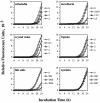Development of an improved selective agar medium for isolation of Yersinia pestis
- PMID: 14532026
- PMCID: PMC201198
- DOI: 10.1128/AEM.69.10.5787-5792.2003
Development of an improved selective agar medium for isolation of Yersinia pestis
Abstract
Existing media designed for selective isolation of clinically important members of the genus Yersinia were found to be unsatisfactory for the growth and isolation of Yersinia pestis. We report the development of a new selective agar medium (termed BIN) that supports the growth of Y. pestis. The development of the formulation of this medium was based on a fluorescence screening system designed for monitoring bacterial growth on semisolid media, using a green fluorescent protein-expressing strain. High-throughput combinatorial experiments can be conducted for the quantitative evaluation of the effect of different medium components on growth. Generation of fluorescence plots in this system, using microplates, allowed the quantitative evaluation of the growth rate of Y. pestis EV76 cultures in different agar compositions. The final BIN formulation is based on brain heart infusion agar, to which the selective agents irgasan, cholate salts, crystal violet, and nystatin were introduced. It was found that BIN agar is more efficient in supporting colony formation and recovery of Y. pestis than are the conventional semisolid media MacConkey agar and Yersinia-selective agar (cefsulodin-irgasan-novobiocin agar). The advantage of BIN over other media has been also demonstrated in recovering virulent Y. pestis from the mixed bacterial populations found in decaying carcasses of infected mice. The BIN medium is suggested as a selective medium for isolation and recovery of Y. pestis from various backgrounds.
Figures



Similar articles
-
Selective isolation of Yersinia pestis from plague-infected fleas.J Microbiol Methods. 2010 Jul;82(1):95-7. doi: 10.1016/j.mimet.2010.03.019. Epub 2010 Apr 10. J Microbiol Methods. 2010. PMID: 20385178 Free PMC article.
-
CYP broth: a tool for Yersinia pestis isolation in ancient culture collections and field samples.Appl Microbiol Biotechnol. 2023 Apr;107(7-8):2653-2660. doi: 10.1007/s00253-023-12452-0. Epub 2023 Mar 10. Appl Microbiol Biotechnol. 2023. PMID: 36897342
-
Improved Selective BIN Agar for a Better Rate of Yersinia pestis Isolation from Primary Clinical Specimens in Suspected Madagascar Plague Cases.J Clin Microbiol. 2021 Jul 19;59(8):e0056421. doi: 10.1128/JCM.00564-21. Epub 2021 Jul 19. J Clin Microbiol. 2021. PMID: 33980652 Free PMC article.
-
Long-term persistence of virulent Yersinia pestis in soil.Microbiology (Reading). 2008 Sep;154(Pt 9):2865-2871. doi: 10.1099/mic.0.2007/016154-0. Microbiology (Reading). 2008. PMID: 18757820
-
[Methods of diagnosis and differentiation of plague pathogen: approaches to detection of atypical strains of Yersinia pestis by molecular biology. Part I].Mol Gen Mikrobiol Virusol. 2006;(1):3-6. Mol Gen Mikrobiol Virusol. 2006. PMID: 16512602 Review. Russian.
Cited by
-
Genomic Insights into a New Citrobacter koseri Strain Revealed Gene Exchanges with the Virulence-Associated Yersinia pestis pPCP1 Plasmid.Front Microbiol. 2016 Mar 16;7:340. doi: 10.3389/fmicb.2016.00340. eCollection 2016. Front Microbiol. 2016. PMID: 27014253 Free PMC article.
-
Evolutionary selection of biofilm-mediated extended phenotypes in Yersinia pestis in response to a fluctuating environment.Nat Commun. 2020 Jan 15;11(1):281. doi: 10.1038/s41467-019-14099-w. Nat Commun. 2020. PMID: 31941912 Free PMC article.
-
Bacterial Concentration and Diversity within Repetitive Aliquots Collected from Replicate Continuous-Flow Bioreactor Cultures.Open Microbiol J. 2008;2:60-5. doi: 10.2174/1874285800802010060. Epub 2008 May 23. Open Microbiol J. 2008. PMID: 19088912 Free PMC article.
-
Beating the Bio-Terror Threat with Rapid Antimicrobial Susceptibility Testing.Microorganisms. 2021 Jul 19;9(7):1535. doi: 10.3390/microorganisms9071535. Microorganisms. 2021. PMID: 34361970 Free PMC article. Review.
-
Selective isolation of Yersinia pestis from plague-infected fleas.J Microbiol Methods. 2010 Jul;82(1):95-7. doi: 10.1016/j.mimet.2010.03.019. Epub 2010 Apr 10. J Microbiol Methods. 2010. PMID: 20385178 Free PMC article.
References
-
- Aleksic, S., and J. Bockemuhl. 1999. Yersinia and other Enterobacteriaceae, p. 483-496. In P. R. Murray, E. J. Baron, M. A. Pfaller, F. C. Tenover, and R. H. Yolken (ed.), Manual of clinical microbiology, 7th ed. American Society for Microbiology, Washington, D.C.
-
- Ben-Gurion, R., and I. Hertman. 1958. Bacteriocin-like material produced by Pasteurella pestis. J. Gen. Microbiol. 19:289-297. - PubMed
-
- Butler, T. 2000. Yersinia species, including plague, p. 2406-2414. In G. L. Mandell, J. E. Bennett, and R. Dolin (ed.), Principles and practice of infectious diseases, 5th ed. Churchill Livingstone, Philadelphia, Pa.
-
- Campbell, G. L., and D. T. Dennis. 1998. Plague and other Yersinia infections, p. 975-983. In A. S. Fauci, E. Braunwald, K. J. Isselbacher, J. D. Wilson, J. B. Martin, D. L. Kasper, S. L. Hauser, and D. L. Longo (ed.), Harrison's principles of internal medicine. McGraw Hill, New York, N.Y.
Publication types
MeSH terms
Substances
LinkOut - more resources
Full Text Sources
Medical
Molecular Biology Databases

